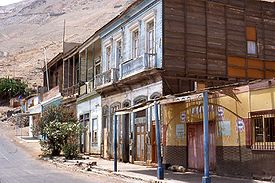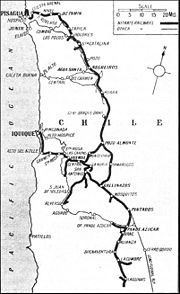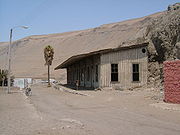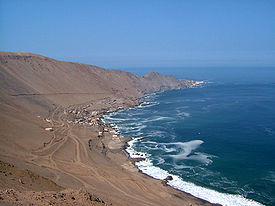
Pisagua
Encyclopedia

Chile
Chile ,officially the Republic of Chile , is a country in South America occupying a long, narrow coastal strip between the Andes mountains to the east and the Pacific Ocean to the west. It borders Peru to the north, Bolivia to the northeast, Argentina to the east, and the Drake Passage in the far...
an port on the Pacific Ocean
Pacific Ocean
The Pacific Ocean is the largest of the Earth's oceanic divisions. It extends from the Arctic in the north to the Southern Ocean in the south, bounded by Asia and Australia in the west, and the Americas in the east.At 165.2 million square kilometres in area, this largest division of the World...
, located in Huara
Huara
Huara is a Chilean village and commune in Tamarugal Province, Tarapacá Region. It is located or northeast of Iquique. The village is crossed by the Pan-American Highway and is the crossing point for the road that goes to Oruro in Bolivia...
comuna (municipality), in Tarapacá Region
Tarapacá Region
The I Tarapacá Region is one of Chile's 15 first order administrative divisions. It borders the Chilean Arica and Parinacota Region to the north, Bolivia's Oruro Department on the east, the Antofagasta Region on the south and the Pacific Ocean on the west. The port city of Iquique The I Tarapacá...
, northern Chile. In 2007, the new province of El Tamarugal was established and the comuna of Huara, previously within the province of Iquique, was incorporated to the newly created province.
Early history

Nitric acid
Nitric acid , also known as aqua fortis and spirit of nitre, is a highly corrosive and toxic strong acid.Colorless when pure, older samples tend to acquire a yellow cast due to the accumulation of oxides of nitrogen. If the solution contains more than 86% nitric acid, it is referred to as fuming...
.
Pisagua was founded in 1611 after an edict by the Viceroy
Viceroy
A viceroy is a royal official who runs a country, colony, or province in the name of and as representative of the monarch. The term derives from the Latin prefix vice-, meaning "in the place of" and the French word roi, meaning king. A viceroy's province or larger territory is called a viceroyalty...
of Peru
Peru
Peru , officially the Republic of Peru , is a country in western South America. It is bordered on the north by Ecuador and Colombia, on the east by Brazil, on the southeast by Bolivia, on the south by Chile, and on the west by the Pacific Ocean....
which established a base from which it could be possible to stem the illegal traffic of gold and silver flowing from the important mines of Potosí
Potosí
Potosí is a city and the capital of the department of Potosí in Bolivia. It is one of the highest cities in the world by elevation at a nominal . and it was the location of the Spanish colonial mint, now the National Mint of Bolivia...
and Oruro
Oruro, Bolivia
Oruro is a city in Bolivia with a population of 235,393 , located about equidistant between La Paz and Sucre at approximately 3710 meters above sea level. It is the capital of the department of Oruro....
, in the Highlands of the "Audiencia of Charcas", to the British and Dutch pirates operating in the Corregimiento de Arica
Arica
Arica is a city in northern Chile. "Arica" may also refer to:Places* Arica and Parinacota Region, Chile* Arica Airport , Chile* Arica, Amazonas, town in Colombia* Rio Aricá-açu, tributary of the Cuiabá River south of Cuiabá, BrazilOther...
. Thus, Pisagua became a minor port, subjected to the major Port of San Marcos de Arica.
This settlement, known today as 'Pisagua Viejo' (Old Pisagua) developed at the south side of the Quebrada Tiliviche, on part of an extensive ancient midden deposit
Midden
A midden, is an old dump for domestic waste which may consist of animal bone, human excrement, botanical material, vermin, shells, sherds, lithics , and other artifacts and ecofacts associated with past human occupation...
. Some adobe ruins remain.
The "Nitrate boom"
It was not until 1810 when large nitrateSodium nitrate
Sodium nitrate is the chemical compound with the formula NaNO3. This salt, also known as Chile saltpeter or Peru saltpeter to distinguish it from ordinary saltpeter, potassium nitrate, is a white solid which is very soluble in water...
("salitre" or saltpeter
Sodium nitrate
Sodium nitrate is the chemical compound with the formula NaNO3. This salt, also known as Chile saltpeter or Peru saltpeter to distinguish it from ordinary saltpeter, potassium nitrate, is a white solid which is very soluble in water...
) deposits were discovered in the Corregimiento de Tarapacá that Pisagua became an important port due to its major role in the export of this product. Tidal waves forced the transfer of Pisagua to the place where it lies today, in 1836. This site is a small plain located between the peninsulas of Punta Pichalo and Punta Pisagua, about 3 km South of Pisagua Viejo.
The War of the Pacific
On November 2, 1879 Pisagua was occupied by Chilean troops during the Guerra del PacíficoWar of the Pacific
The War of the Pacific took place in western South America from 1879 through 1883. Chile fought against Bolivia and Peru. Despite cooperation among the three nations in the war against Spain, disputes soon arose over the mineral-rich Peruvian provinces of Tarapaca, Tacna, and Arica, and the...
, in the "Battle of Pisagua
Battle of Pisagua
The Battle of Pisagua , was a landing operation of the War of the Pacific, fought on November 2, 1879, between Chile and the combined forces of Bolivia and Peru. The Chilean army commanded by Erasmo Escala, supported by the Chilean Fleet, launched an amphibious assault, led by Gen...
". After the war, Pisagua went from Peruvian hands to Chilean administration.
The heydays of the town
Pisagua became an important port of the South PacificPacific Ocean
The Pacific Ocean is the largest of the Earth's oceanic divisions. It extends from the Arctic in the north to the Southern Ocean in the south, bounded by Asia and Australia in the west, and the Americas in the east.At 165.2 million square kilometres in area, this largest division of the World...
during the nitrate boom of the 1870s. During the first years of the 20th century, Pisagua had become one of the most important ports of the whole country (after Valparaíso
Valparaíso
Valparaíso is a city and commune of Chile, center of its third largest conurbation and one of the country's most important seaports and an increasing cultural center in the Southwest Pacific hemisphere. The city is the capital of the Valparaíso Province and the Valparaíso Region...
and Iquique
Iquique
Iquique is a port city and commune in northern Chile, capital of both the Iquique Province and Tarapacá Region. It lies on the Pacific coast, west of the Atacama Desert and the Pampa del Tamarugal. It had a population of 216,419 as of the 2002 census...
), with offices from major banks, and one of the most beautiful cities on the Southern Pacific coast.


Railway history
The construction of a standard gaugeStandard gauge
The standard gauge is a widely-used track gauge . Approximately 60% of the world's existing railway lines are built to this gauge...
railway line to connect Pisagua with the interior started in about 1865, while Pisagua was still a Peruvian possession. Work continued under Chilean administration, and by 1935 Pisagua was the northern terminius of a 400 mile/640 km network of main and branch lines, with a connection to Iquique, the principal terminus of the line. Trains climbed from sea level at Pisagua to the interior plateau via three reversing zig-zags
Zig Zag (railway)
A railway zig zag, also called a switchback, is a way of climbing hills in difficult country with a minimal need for tunnels and heavy earthworks. For a short distance , the direction of travel is reversed, before the original direction is resumed.A location on railways constructed e.g...
and a heavily graded line. Supplies for the interior towns and nitrate works were hauled up from the coast, and nitrate for export made up the return load. The principal traffic was always nitrate, after which came fuel, passengers, perishables, parcels, general merchandise, and live stock. Water for the steam locomotives and the town relied on two wells at Dolores (see map), 33 mi/53 km from Pisagua, which today still derives its water from this source.
Decline
When the nitrate boom came to an end, the port of Pisagua could keep some degree of importance because of its new role in the fishmeal industry. However, at the end of the 1950s, Pisagua lost most of its population and economic base and went into precipitous decline and even ceased to be the third town in importance of TarapacáTarapacá
Tarapacá may refer to:*Tarapacá Province, Chile, a former province, now divided into**Tarapacá Region**Arica-Parinacota Region*Tarapacá Department , a former department of Peru...
province (after Arica and Iquique).
Pisagua as a prison camp
Pisagua has often been used as a concentration camp for political prisoners. This happened during the rule of Carlos Ibáñez del CampoCarlos Ibáñez del Campo
General Carlos Ibáñez del Campo was a Chilean Army officer and political figure. He served as dictator between 1927 and 1931 and as constitutional President from 1952 to 1958.- The coups of 1924 and 1925 :...
(for male homosexuals), as well as that of Gabriel González Videla
Gabriel González Videla
Gabriel González Videla was a Chilean politician. He was a deputy and senator in the Chilean Congress and was President of Chile from 1946 to 1952...
(for communists, anarchists and revolutionaries) and more recently, during Augusto Pinochet
Augusto Pinochet
Augusto José Ramón Pinochet Ugarte, more commonly known as Augusto Pinochet , was a Chilean army general and dictator who assumed power in a coup d'état on 11 September 1973...
's dictatorship
Dictatorship
A dictatorship is defined as an autocratic form of government in which the government is ruled by an individual, the dictator. It has three possible meanings:...
(for left-wing militants). Many bodies have been found under the waters of the port and several graves have been discovered in Pisagua since the end of Pinochet's military regime. Pisagua is geographically isolated, with the ocean on one side and a big desert on the other.
Pisagua today

Municipality
A municipality is essentially an urban administrative division having corporate status and usually powers of self-government. It can also be used to mean the governing body of a municipality. A municipality is a general-purpose administrative subdivision, as opposed to a special-purpose district...
of Huara, which has only 2,600 inhabitants itself.

